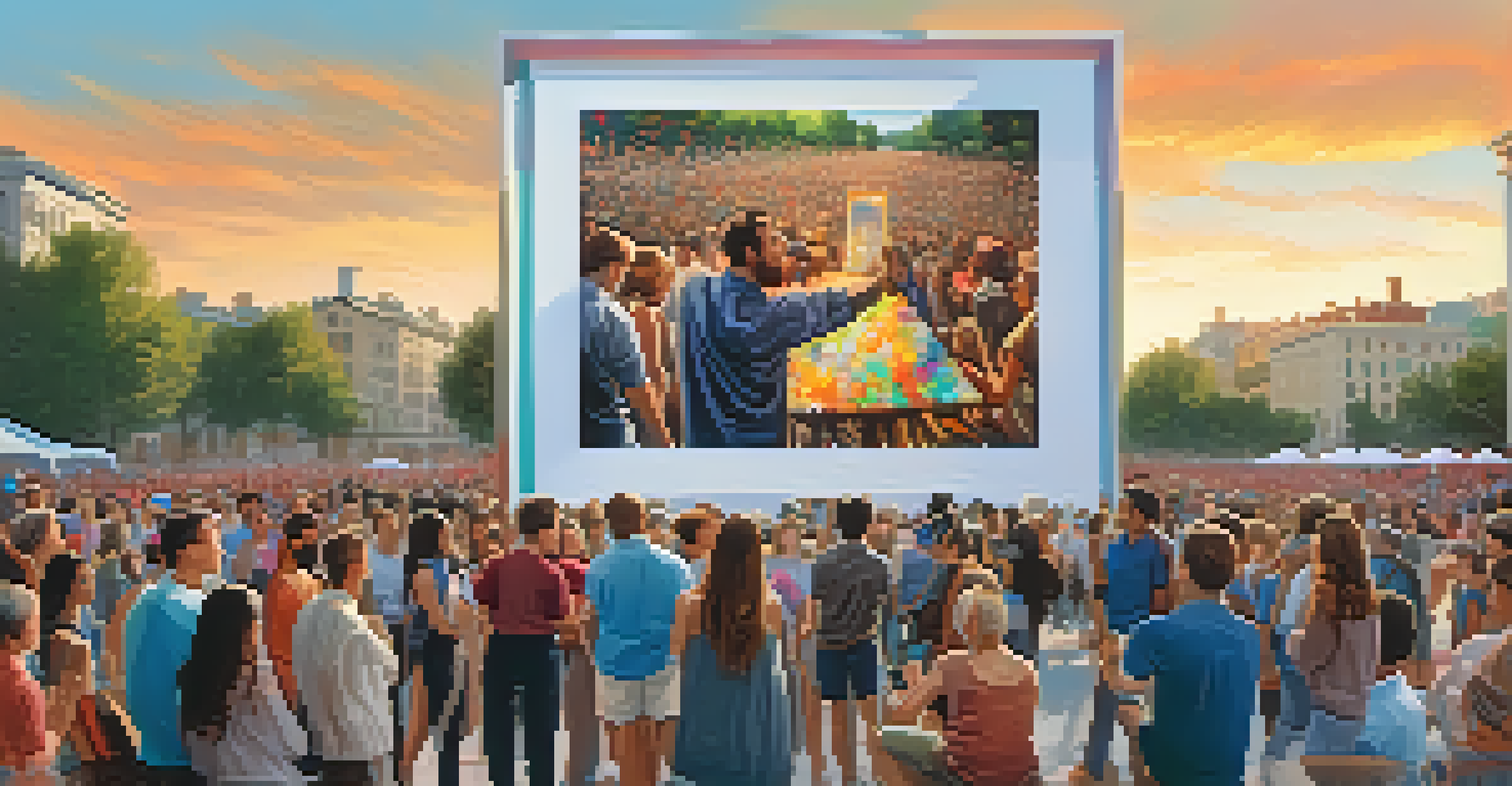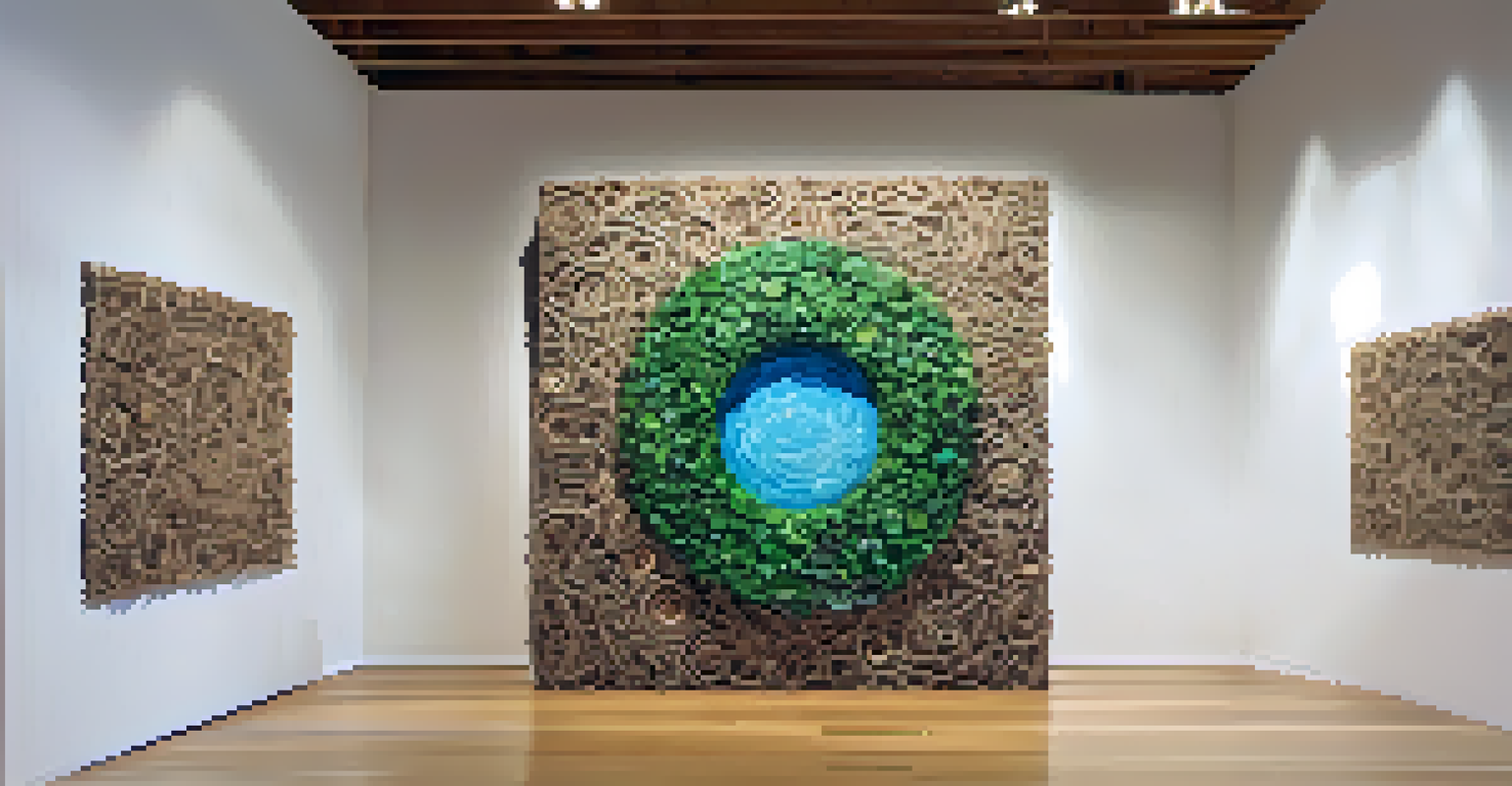Art and Activism: Engaging Communities for Social Change

Understanding the Connection Between Art and Activism
Art and activism are intertwined through their shared goal of inspiring change. Art has the ability to capture emotions, provoke thought, and spark conversations that can lead to action. For instance, think of how a powerful mural can transform a dull wall into a canvas that speaks for a community's struggles and aspirations.
Art is not a mirror to reflect the world, but a hammer with which to shape it.
Activism often requires a voice, and art provides that voice in a unique way. Whether through music, visual arts, or performance, artists can convey messages that resonate deeply with people. This connection can mobilize communities and encourage them to engage in social issues.
When art is used as a tool for activism, it not only raises awareness but also fosters a sense of belonging and identity among community members. This collaborative spirit can amplify voices that might otherwise go unheard, emphasizing the importance of collective action.
Historical Examples of Art as Activism
Throughout history, artists have used their work to address social and political issues. For example, the Harlem Renaissance was a cultural movement where African American artists expressed their identity and fought against racial inequality through literature and visual arts. This period showcased how art can challenge societal norms and inspire change.

Another powerful example is the AIDS Memorial Quilt, which started in the 1980s as a way to remember those lost to the disease. This quilt not only served as a memorial but also sparked dialogue about AIDS awareness and prevention, illustrating how art can bring communities together for a common cause.
Art Inspires Social Change
Art serves as a powerful medium that captures emotions and provokes thought, driving communities to engage in social issues.
These historical instances remind us that art is not just about aesthetics; it’s a platform for storytelling and advocacy. By reflecting the lived experiences of marginalized communities, artists can illuminate issues and drive the narrative toward social justice.
The Role of Community Engagement in Artistic Activism
Community engagement is crucial in ensuring that artistic activism resonates with the intended audience. By involving community members in the creative process, artists can create work that reflects their unique experiences and perspectives. This collaborative approach not only empowers individuals but also strengthens community bonds.
The role of the artist is to make the revolution irresistible.
For instance, community art projects, like local murals or performances, allow residents to express their thoughts on social issues directly. These projects can serve as a catalyst for dialogue, encouraging people to share their stories and concerns, which fosters a sense of ownership over the message.
When communities feel involved in the artistic process, the impact of the artwork can be profound. It becomes more than just a piece of art; it transforms into a collective expression of identity, resilience, and hope.
Digital Platforms: Expanding Reach for Artistic Activism
In today's digital age, artists have unprecedented access to platforms that can amplify their activism. Social media, for instance, allows artists to reach global audiences in real-time, spreading their messages far beyond local communities. This expanded reach can inspire action and solidarity on a larger scale.
Take the example of viral art campaigns that address social issues, such as the #MeToo movement. Artists and activists used digital platforms to share their work and experiences, creating a powerful network of support and advocacy. This demonstrates how art can transcend geographical boundaries and connect people with shared goals.
Community Involvement is Key
Engaging community members in artistic activism fosters a sense of belonging and empowers individuals to express their unique perspectives.
Moreover, digital art forms, like video and graphic design, can be particularly effective in conveying complex messages quickly and engagingly. By harnessing technology, artists can engage diverse audiences and mobilize them for social change.
Challenges Faced by Artists in Activism
While art can be a powerful tool for activism, artists often face numerous challenges. One significant obstacle is funding; many artists struggle to secure financial support for their projects. Without adequate resources, it can be difficult to bring ambitious ideas to life and reach the intended audience.
Additionally, artists may encounter resistance from authorities or communities that oppose their messages. This pushback can stifle creativity and discourage artists from pursuing projects that address sensitive topics. However, these challenges can also serve as a motivator for artists to push boundaries and innovate.
Ultimately, the resilience of artists in the face of adversity is what often drives impactful activism. By navigating these challenges, they can create work that not only inspires social change but also encourages others to join the movement.
The Impact of Collaborative Art Projects
Collaborative art projects have the power to unite people from diverse backgrounds around a common cause. These projects often involve a mix of artists and community members working together, blurring the lines between creator and audience. This shared experience fosters understanding and empathy among participants.
For example, community theater productions that tackle local social issues can create a safe space for discussion and reflection. Participants can explore their emotions, share personal stories, and collectively envision solutions, all while building trust within the community.
Digital Platforms Amplify Voices
The rise of digital platforms enables artists to reach wider audiences, spreading their messages and inspiring action on a global scale.
Such collaborations not only yield meaningful art but also contribute to community cohesion. By working together, individuals can transcend their differences and focus on what unites them, ultimately enhancing the impact of their collective message.
Looking Ahead: The Future of Art and Activism
As we look to the future, the intersection of art and activism is likely to evolve further. With emerging technologies and new platforms, artists have even more opportunities to engage communities and advocate for change. This evolution could lead to innovative forms of activism that we can’t yet imagine.
Moreover, as social issues continue to rise globally, the role of artists as activists will remain critical. Their ability to tell stories, spark emotions, and inspire action will be essential in shaping public discourse and influencing policy decisions.

Ultimately, the future of art and activism will depend on the continued commitment of artists and communities to work together. By harnessing creativity and collaboration, they can create a more just and equitable world for all.